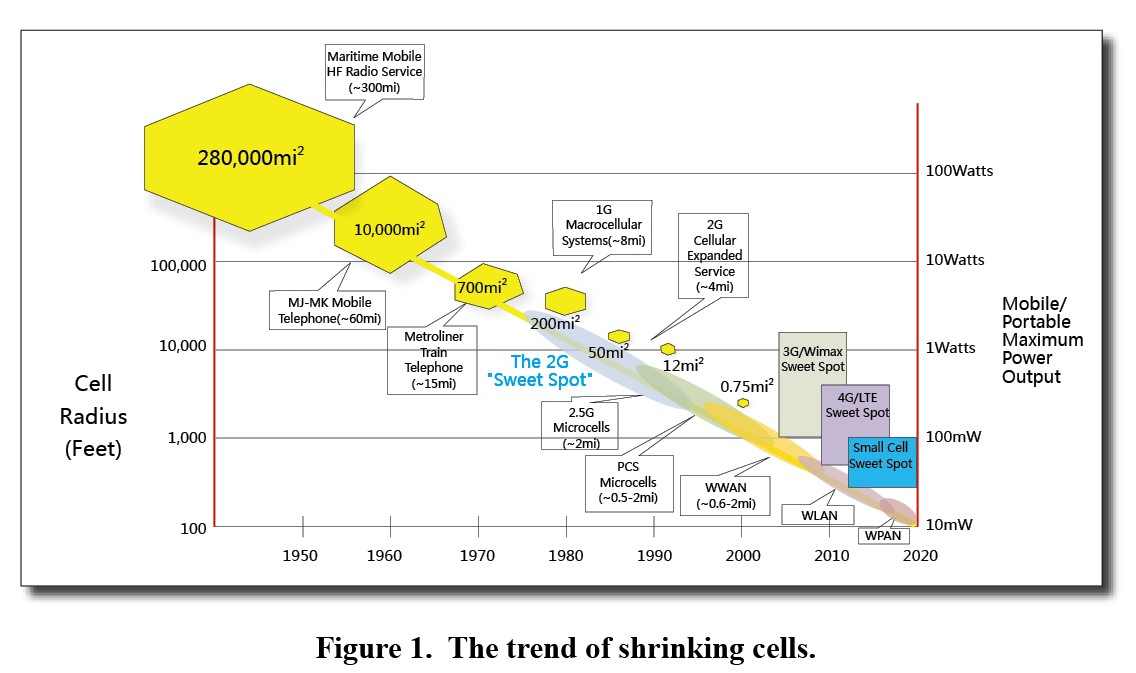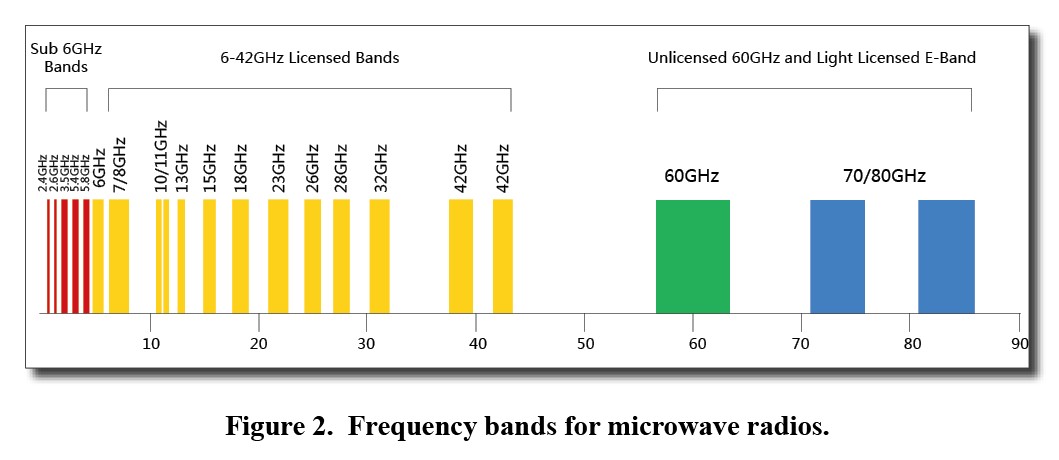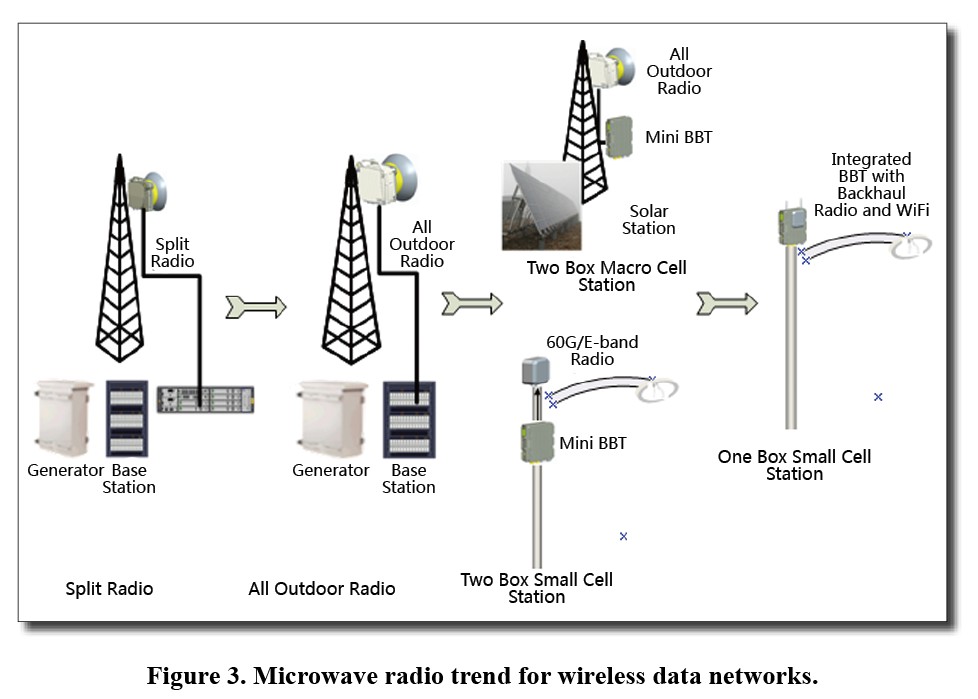Evolution of Microwave Radio for Modern Communication Networks
Mobile Data Explosion
These predictions are overwhelming for any service provider looking to prepare its cellular networks for the demands of users addicted to mobile data. Small cells, carrier WiFi, backhaul, and backbone fiber networks are solutions to meeting increased demand. The following equation is used to determine network capacity:
Network capacity (bps) = quantity of spectrum (Hz) × cell spectrum efficiency (bps/Hz) × number of cells
The easiest way to cope with data traffic is to increase the number of cells by having more small cells. Fig. 1 shows cell sizes over the past 70 years as demand for capacity has increased. 4G LTE and small cells will inevitably follow the trend of shrinking cell size.

Microwave Radio for Small Cells
A heterogeneous network is a combination of small and macro-cell layers. Small cell base stations are typically deployed in addition to the existing macro layer.
The key features of a small-cell backhaul are low capex and opex, fast deployment, and ubiquitous reach. Small cell base stations can be deployed in small traffic hotspots, line of sight (LOS) and non line-of-sight (NLOS) locations, and over short and long distances.
Backhaul is a key challenge. Fig. 2 shows all available frequency bands for microwave radio applications.

The top three small-cell backhaul candidates are:
- fiber
- NLOS sub-6 GHz MIMO
- millimeter-wave point-to-point LOS radios at 60 GHz or E-bands.
There is no single solution, and the combination of these three technologies is determined according to cell location, coverage size, and capacity requirements.
Fiber is selected whenever it is available because it has extremely large capacity.
NLOS sub-6 GHz MIMO can be selected in 2.4 GHz, 2.6 GHz, 3.5 GHz, 5.4 GHz, and 5.8 GHz bands. Because it does not require LOS, it allows for easier planning and installation, and it has ubiquitous reach. However, it also has narrow channel bandwidth at 10, 20, or 40 MHz, co-channel interference, and strong shadow fading.
Millimeter-wave point-to-point radios at 60 GHz or E-band at 70−86 GHz provide wide channel bandwidths of 250 MHz and 500 MHz and can support high traffic capacity of more than 2.5 Gbps. Radios in the unlicensed 60 GHz band and in the loosely licensed E-band have high frequency reuse and minimum frequency planning because of their fast attenuation and high oxygen absorption. These millimeter-wave radios are also highly immune to interference and have almost no selective fading and fog attenuation. They are quick to deploy and require low capex and opex. On the other hand, they are line-of-sight only and are not very scalable.
Small-cell backhaul has the following features:
- can be mounted on a light pole, utility pole, wall and roof top instead of traditional pole and tower
- environment friendly, no parabolic antenna
- can be quickly and easily installed in less than 20 minutes
- low power consumption, PoE is preferred, less than 25.5 W
- one box solution, high integration with small cells
- can be integrated with a GPS receiver for future unit tracking, service and replacement
- LOS: 1 Gbps typical, full duplex, one-way latency less than 50 μs per hop
- NLOS: 150 Mbps typical, full duplex, one-way latency less than 1 ms per hop
- support links of up to 400 m with 99.99% availability
- low cost.
Microwave Radio Transition to Full IP
Packet based IP/Ethernet transport has many advantages over traditional TDM:
- unified platform to consolidate disparate transport networks for different traffic types
- lower cost to deploy and maintain
- more efficient bandwidth use
- easily scalable to accommodate growing capacity demands.
Over the past decade, microwave radios have transitioned from TDM only to TDM and IP/Ethernet hybrid and finally to full IP/Ethernet. A sophisticated network processor became a mandatory part of the radio that provides comprehensive layer 2, layer 3, and multiprotocol label switching (MPLS).
MPLS brings the best of TDM networks to packet IP/Ethernet networks. It ensures connection between two endpoints, and QoS is guaranteed by a service-level agreement.
Synchronization distribution, which was a common function in TDM radios, is a big challenge in IP/Ethernet networks. Two solutions are widely adopted:
- synchronous Ethernet. This is designed to distribute a reference frequency on the physical layer of the Ethernet network.
- IEEE 1588v2 precision time protocol. This distributes both time and reference frequencies.
Microwave radio has to meet strict synchronization distribution requirements of ITU-T G.8262 to satisfy the demands of 4G LTE networks.
Two Highs and Two Lows
Microwave radios continue to be the key deployment solution for mobile backhaul networks and traditional private networks. Microwave radios are moving towards high throughput, high output power, low power consumption, and low cost.
High throughput is the most important requirement for next-generation wireless data networks. The following techniques are used to achieve high throughput:
- high bandwidth and high frequency bands
◇ ETSI: 3.5/7/14/28/56 MHz and moving to 112 MHz
◇ FCC: 5/10/20/30/40/50 MHz
◇ 60 GHz/E-band: 250 MHz and 500 MHz
- high modulation
◇ QPSK/16/32/64/128/256 QAM and moving to 512/1024 QAM
◇ 2048 QAM and 4096 QAM coming
- cross-polarization interference cancellation (XPIC)
- header and packet compression
◇ up to 30% L2 compression is possible for 64 byte packets
◇ compression ratio is statistical (on large packets becomes negligible)
◇ combined L2+L3 (IPv4+UDP) can provide up to 100% gain for 64 byte packets
- IF/RF combining
- MIMO: multiple input/multiple output and spatial combining.
High output power continues to be an important parameter for microwave radios. Output power is directly linked to system gain. For the same system gain, higher output power can be accommodated with smaller antennas and towers and with lower installation cost. High output power and dynamic range are the main competitive features. Common techniques for achieving high output power are
- high P1dB/IM3 power amplifiers
- high efficiency GaN devices with pre-distortion techniques
- Doherty amplifier
- various pre-distortion techniques
- power combining.
Low power consumption is a new trend and key to "green" branding. Ecological solar base stations will become more and more popular. Power over Ethernet (POE) and longer-lasting solar batteries are firm requirements for microwave radios to have low power consumption. Modern techniques for reducing power consumption include
- pre-distortion
◇ adaptive analog pre-distortion
◇ adaptive digital pre-distortion
◇ open loop digital pre-distortion
◇ remote adaptive digital pre-distortion
- bias
◇ class AB, class B/C, and class F
◇ adaptive bias per envelop detecting
◇ fixed bias per output power level
- common rail devices
- CMOS and SiGe low power consumption devices
- high efficiency DC/DC converters
- optimized system designs
- alternative energy, integrated with solar power generating devices.
Low cost is always the ultimate goal, not for devices but also in overall system design, mass production processes, installation and manufacturing. Low cost involves:
- highly integrated system on chips
- using either CMOS or SiGe processes
- design for various applications
- design for installation
- design for test and manufacturing
- design for system integration with base station.

Summary
Microwave radios are transitioning from split, outdoor radios to one or two boxes integrated with a small-cell base station and WiFi (Fig. 3). With the wireless data network, full IP with standard multi-gigabit Ethernet connection is mandatory. The mobile and wireless industries have succeeded beyond expectation. Microwave radios will continue to be a critical part of growing wireless data networks.